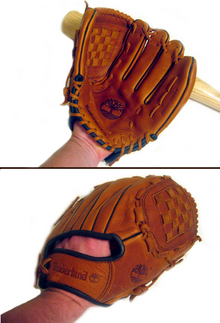Baseball glove
The baseball glove or baseball glove (in English for the glove of the catcher and first baseman often Wed ) is a sports device in Baseball Sport is supported by the team on the defensive. The glove is designed to make it easier to catch hits from the battler , passes from fellow players and throws from the pitcher . In addition, the glove protects against pain and injuries that could occur due to the hardness of a baseball when caught.
history
In the history of baseball, gloves were not used on the defensive right from the start. It was not until the end of the 19th century that players began to play with gloves. The ancestor of the baseball glove is said to be Doug Allison , who wore a glove for the first time in 1870 after injuring his catching hand.
The first baseball gloves were simple leather gloves that had the fingertips cut off for better control of the ball. The gloves were then mainly distributed by the first baseman Albert Spalding , who performed significantly better with gloves and found so many imitators. In later years, the company founded Albert Spalding Spalding , a sporting goods manufacturer that still produces and sells baseball gloves.
The size of baseball gloves gradually increased over several decades; From around 1910 onwards, gloves began to be larger than ordinary leather gloves; today's size was only reached towards the middle of the 20th century. Around 1920 "webbing", a leather surface between the thumb and forefinger, was introduced.
variants
Modern baseball gloves differ in shape and size and are specialized for the respective position on the defensive. For example, different fingers are left out or special padding is added - especially with the Catchers Mitt. They are available for left- or right-handed players. A right-hander wears a glove on his left hand, the right hand remains free to throw the ball, and vice versa for a left-hander .
A "Mitt" (German: Fäustling) does not need to have individually shaped fingers; in the case of a "glove", on the other hand, the individual fingers of the glove must be clearly separated. Only the catcher and the first baseman are allowed to use a "mitt".
One distinguishes between:
| Glove | particularities |
|---|---|
| Catcher's Mitts | The catcher's gloves are particularly thickly padded in order to be able to catch the pitcher's very fast and hard balls painlessly. |
| Outfielder's Gloves | The outfielder's gloves are as large as possible and have deep pockets so that they can catch the ball as well as possible. The "webbing" between thumb and forefinger is designed as a grid, so that you can see through for better catching fly balls when you hold the glove in front of your face. |
| Infielders' Gloves | The gloves of the infielders are slightly smaller than those of the outfielders in order not to restrict the speed and mobility of the players too much. The exception is the first baseman's glove. |
| First Baseman's Mitts | The first baseman's glove is larger than that of the other infielders. The reason for this is the fact that the first baseman has to catch a large part of the throws of his teammates in order to identify the batsman at first base. The slightly larger glove mainly helps to better catch badly thrown balls. |
| Pitchers' Gloves | The pitcher's glove is sewn very tightly and thus protects the ball or the hand from being seen from outside so that the batsman cannot see the pitcher grabbing the ball, as this may allow him to estimate the type of the next throw. |
| Switch-Thrower's Gloves | These gloves have two thumb pockets instead of one. This means that players who take turns throwing right or left can switch them from one hand to the other. |
Player on the offensive
The team that is on the offensive does not wear gloves in the sense of the classic baseball gloves. The batter wears so-called batting gloves , thin leather gloves that are supposed to improve the secure grip of the baseball bat and protect against blisters and pain. Batting gloves are not mandatory in the regulations and are therefore not worn by all batsmen.
literature
- Noah Liberman: Glove Affairs. The Romance, History, and Tradition of the Baseball Glove . Triumph Books, Chicago 2003, ISBN 1-57243-420-1 . (English)
- Robert Gray: The Baseball Glove . In: Boys' Life , February 1981 edition, Boy Scouts of America , ISSN 0006-8608 , p. 14. ( online excerpt , English)
Individual evidence
- ^ "Baseball 'Glove Affairs'". (Eng.) NPR . 4 September 2008. 27 June 2008.
- ^ Bennett, R. (March 31, 2006). Glovology TCS Daily.
